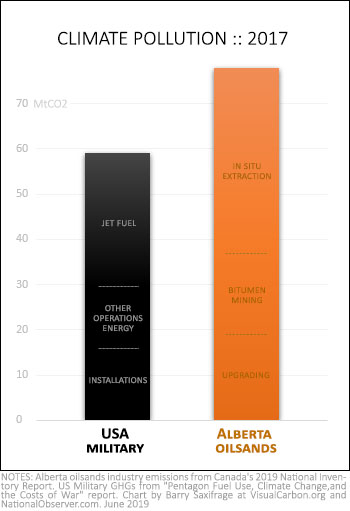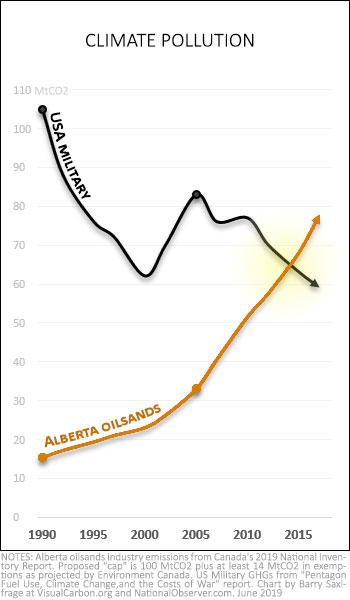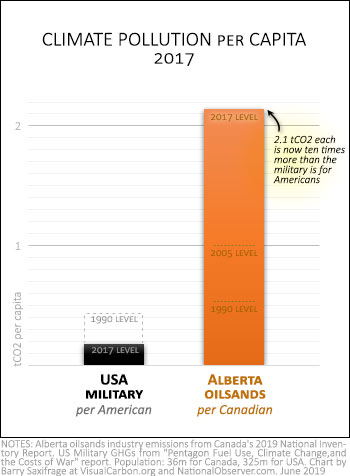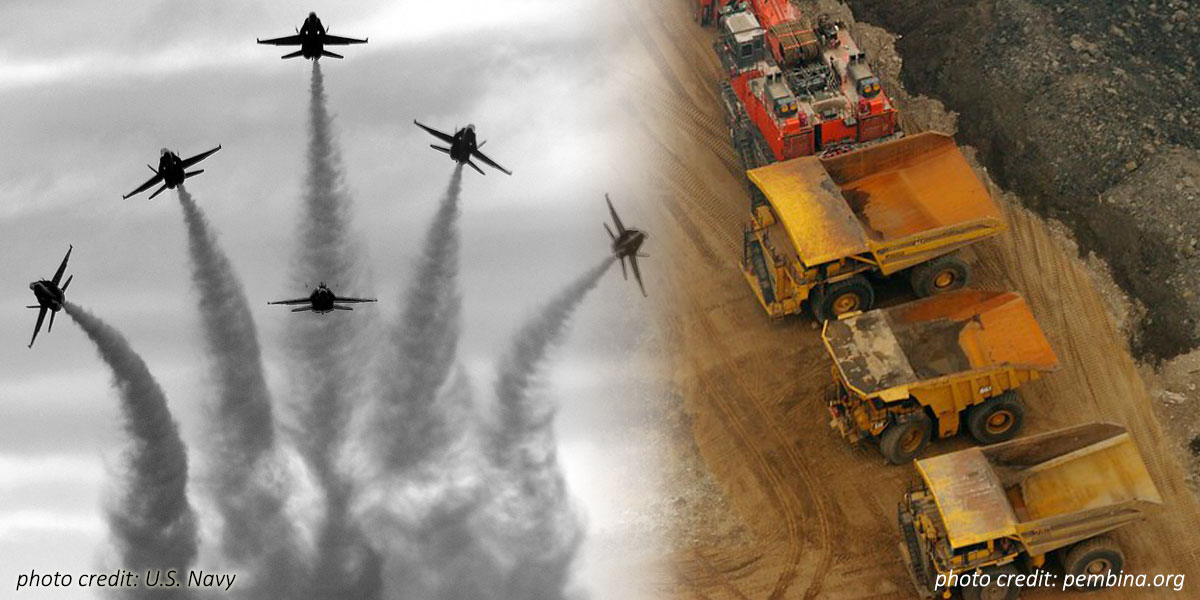The United States military is one of the world's largest climate polluters — emitting more than entire European countries like Sweden or Norway. That's according to a new report that estimates the U.S. Department of Defence's worldwide emissions at nearly 60 million tonnes (MtCO2).
Here in Canada, Alberta's oilsands industry emits even more climate pollution than that.
I've put together a few charts to illustrate both the scale and emissions trends from these two enormous climate polluters.
Current climate pollution
U.S. military
A new report out of Brown University, "Pentagon Fuel Use, Climate Change, and the Costs of War", digs into the climate pollution from the U.S. Department of Defence (DOD). This includes the U.S. Army, Navy, Air Force, Marines and other defence agencies.
The report highlights just how massive and globe-spanning the U.S. military is: "The United States spends more on the military than any other country in the world, certainly much more than the combined military spending of its major rivals, Russia and China. Authorized at over $700 billion [per year]."
The report calculates that the worldwide emissions from the sprawling U.S. military were 59 MtCO2 in 2017. That's the black bar in my chart below. It includes emissions from fighting wars and other "overseas contingency operations."

Around a third of its emissions come from roughly 500 military installations, which include more than half a million buildings around the globe.
The lion's share of its emissions, however, come from the energy used to carry out its operations. As the report notes: "With an armed force of more than two million people … and the most advanced military aircraft the DOD is the world’s largest institutional user of petroleum."
All told, the U.S. military currently burns 100 million barrels a year. That's roughly two million litres every hour.
Around 70 per cent is jet fuel for bombers, jet fighters, cargo planes and other support aircraft. These aircraft burn gallons of this fossil fuel per mile.
Much of the rest is diesel for vehicles. In just one example, the report notes that the U.S. Army alone has around 60,000 HUMVEEs that burn one gallon every four to eight miles.
Alberta oilsands industry
Now let's look at the climate pollution from Alberta's oilsands industry. That's the orange bar on the chart. This one part of this one province's oil and gas sector emitted 78 MtCO2.
As you can see, that is one third more than the emissions from the entire U.S. military. In fact, there are more than 160 countries that emit less climate pollution than Alberta's oilsands industry.
The oilsands emissions data comes from Canada's most recent National Inventory Report (NIR). The NIR shows that roughly half of these emissions came from burning fossil methane (aka “natural”) gas to generate the heat needed to extract bitumen via the "in situ" process. The other half of emissions was split between mining bitumen and upgrading it.
So far, we've looked at current emissions. The long-term trends that got each to this point are just as eye-opening.
My next chart tells that tale.
Long-term climate pollution trends
U.S. Military
The black line on my second chart shows U.S. military emissions data from the report covering 1990 to 2017. It’s a long-term falling trend with some big upward spikes.
Major factors leading to the downward trend, according to the report, include the end the cold war, and the energy reductions spurred on by the U.S. Energy Independence and Security Act of 2007.

The upward surges in emissions were the result of wars and other major "overseas contingency operations." An example of this can be seen in the sharp upward surge after 2000 that resulted from the wars in Afghanistan, Iraq and elsewhere in that region.
Currently, U.S. military emissions are roughly forty per cent below their 1990 levels. While that is lower than it has been, it is still an enormous amount of pollution that exceeds the emissions from many entire nations.
Alberta oilsands industry
The orange line on the chart shows climate pollution from oilsands operations in Alberta.
Back in 1990, emissions from the Alberta oilsands industry were tiny compared to the U.S. military. That was back when Canada first started promising to reduce its climate pollution.
In the nearly three decades since then — as the climate crisis as grown increasingly dangerous — the climate pollution emitted by the oilsands industry in Alberta has exploded.
This industry now emits five times more greenhouse gases than it did in 1990. And seventy per cent of that increase has been piled on just since 2005.
Canada and the U.S. have both promised to reduce emissions from 2005 levels. The U.S. military has been lowering emissions. But Alberta's oilsands industry has been doing the opposite. It has accelerated towards ever more climate disruption.
It's a stunningly rapid rise in climate pollution. And the Alberta oilsands industry isn't planning on stopping the increase.

Planning for more climate pollution
To illustrate what the oilsands industry is planning, I've added a shaded line labelled "proposed cap" to the chart.
It’s in the upper right corner at 114 MtCO2.
According to the most recent projections from Environment Canada, that's how high Alberta's oilsands industry emissions will be by 2030.
It's also the level at which the previous Alberta government promised to "cap" oilsands climate pollution.
As you can see, this "cap" is double what the entire U.S. military emits today. And the newly elected Alberta government campaigned on a promise to eliminate the "cap" all together.
(For an in-depth look into this "cap" and the six exemptions built into it that stretch it far beyond the nominal 100 MtCO2, see here.)
Pollution per person

My final chart shows the burden each of these two massive climate pollution sources add to their country's per capita emissions.
Back in 1990, both emitted roughly the same amount per capita — half a tonne of CO2 each (0.5 tCO2).
The black bar on left shows that the U.S. military’s emissions have fallen since then, to around 0.2 tCO2 per American.
The orange bar on the right shows that Alberta's oilsands industry emissions per Canadian have done the opposite. Their climate pollution jumped dramatically to more than 2.1 tCO2 per Canadian.
This chart also let's you see how the oilsands’ pollution surge has accelerated over time. The oilsands added a half tonne per Canadian in the 15 years up to 2005. Then the industry added twice as much climate pollution per Canadian over the next 12 years.
As a result, the oilsands industry is now a ten times greater climate burden for each Canadian, than the U.S. military is per American.



Comments
"This one part of this one province's oil and gas sector emitted 78 MtCO2."
Good analysis. Just a minor correction:
Oilsands, mining & extraction (16.4 Mt) + Oil sands, in situ (41.7 Mt) + Oilsands, upgrading 22.4 Mt) = Oilsands Total (80.5 Mt).
Further, AB's oil & gas industry GROSSLY under-reports its emissions — of all types. The nominal total (80.5 Mt) is inaccurate.
The oilsands industry has almost certainly surpassed AB's fraudulent cap. "Measured Canadian oil sands CO2 emissions are higher than estimates made using internationally recommended methods" (Nature, 23 April 2019)
"The results indicate that CO2 emission intensities for OS facilities are 13–123% larger than those estimated using publically available data. This leads to 64% higher annual GHG emissions from surface mining operations, and 30% higher overall OS GHG emissions (17 Mt) compared to that reported by industry."
• https://www.nature.com/articles/s41467-019-09714-9
"The additional 17 megatonnes in GHGs discovered over just four bitumen operations puts the measured level closer to 94 megatonnes. Those extra emissions have may also have increased in the last six years, during which time there was a 50-per-cent growth in overall bitumen production. Throw in additional emissions from unanalyzed in situ operations, and we may well be over the 100-megatonne cap now."
"Wildly Underestimated Oilsands Emissions Latest Blow to Alberta’s Dubious Climate Claims" (The Tyee, 03-May-19)
• https://thetyee.ca/Opinion/2019/05/03/Oilsands-Emissions-Wildly-Underes…
Total oilsands emissions including projects that are under construction, have received approval, or are seeking approval "blow well past" AB's fraudulent cap. (Pembina Institute)
All excellent additions to the article, thanks for taking the time to post them. You are correct that oilsands emissions in Canada were listed at 81 MtCO2 for 2017. In this particular article I focused just on the oilsands operations in Alberta which were 78 MtCO2 -- I did this because that is what the "cap" applies to. As you point out, it climbs to 81 MtCO2 if you include oilsands emissions from SK. And likely even more than that if a full accounting of methane leaks/vents/flaring is done.
Have you seen Bill McKibben's comments on the Brown University study over at the New York Review of Books' daily blog? He points out that, "Still—and this is very helpful in understanding the full dimension of our energy dilemma—this is not a particularly large share of the world’s, or even our nation’s, energy consumption. Crawford’s careful analysis shows that the Department of Defense consumes roughly a hundred million barrels of oil a year. The world runs through about a hundred million barrels of oil a day." Understanding the full dimension of our energy dilemma is daunting, but essential. As McKibben goes on to point out: "Denmark, after all, could go dark tomorrow without materially altering the climate change outcome for the planet."
"the Department of Defense consumes roughly a hundred million barrels of oil a year. The world runs through about a hundred million barrels of oil a day."
I.e., the U.S. military — just one branch of the U.S. Govt and one sector of the U.S. economy — accounts for a whole day's worth of the world's annual oil consumption.
That's not a little. That's a lot.
War, aggression, and imperialism account for a significant chunk of global emissions.
For me, at least a bit of a point is the contradiction between Canada being a "climate change leader" and the fact that we produce something on the order of 2 times our world-wide per capita "share" and this against nations that produce very little at all.
A part of the point is also that for all Alberta and Saskatchewan's whining, the two of them together have about 15% of the population of Canada, and they just from tarsands are producing way more than twice the amount per capita of Canada's emissions, even using their understated figures. It would be very interesting to see that calculated and graphed out. And very instructive.
I'd dearly love to see how Trudeau's "plan" deals with that.
Frankly, given that Canada is a highly industrialized country, and thus one of the bigger polluters to begin with, we should be doing more than our per capita share of reductions. Our real share should be calculated on the basis of population of highly industrialized, big polluter countries.
I.e., Doug Ford in Canada should be charging full steam ahead, not resting on Ontario's laurels. Ontario has harvested the low-hanging fruit: time to get on with the challenging stuff.
A thought just came to mind: when Trudeau and McKenna claim they want to be Climate Change Leaders, maybe they're talking about increasing the amount of climate change. Then their program, which has never AFAIK been set out *as* a climate change program.
I wish he'd come to Toronto for a real Q&A, in an open mike session, instead of the staged "town halls."